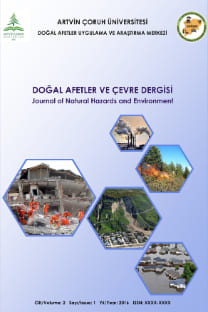Kaolen Türü Killi Zeminlerin Dayanım Özelliklerinin Melamin Formaldehit Sıvı Polimeri Kullanarak İyileştirilmesi
Serbest Basınç Dayanımı, Zemin İyileştirme, Melamin Formaldehit Polimeri, Erozyon, Kaolin, Heyelan
Improving the Strength Properties of Kaolinite Type Clays Using Melamine Formaldehyde Liquid Polymer
Kaolinite, Unconfined Compressive Strength, Soil Stabilization, Melamine Formaldehyde Polymer, Erosion, Landslides,
___
- Ajalloeian R., Matinmanesh H., Abtahi S., Rowshanzamir M., (2013), Effect of polyvinyl acetate grout injection on geotechnical properties of fine sand, Geomechanics and Geoengineering, 8(2), 86–96.
- Al-Khanbashi A., El-Gamal M., (2003), Modification of sandy soil using water-borne Polymer, Journal of Applied Polymer Science, 88(10), 2484–2491.
- Al-Khanbashi A., Abdalla S., (2006), Evaluation of three waterborne polymers as stabilizers for sandy soil, Geotechnical and Geological Engineering, 24(6), 1603–1625.
- Anagnostopoulos C., Hadjispyrou S., (2004), Laboratory study of an epoxy resin grouted sand, Ground Improvement, 8(1), 39–45.
- Anagnostopoulos C., Papaliangas T., (2012), Experimental investigation of epoxy resin and sand mixes, Journal of Geotechnical and Geoenvironmental Engineering, 138(7), 841–849.
- Anagnostopoulos C., Kandiliotis P., Lola M., Karavatos S., (2013), Effect of epoxy resin mixtures on the physical and mechanical properties of sand, Research Journal of Applied Sciences, Engineering and Technology, 7(17), 3478–3490.
- ASTM, (2016), Standard Test Method for Unconfined Compressive Strength of Cohesive Soil, (ASTM D2166M-16). ASTM International, West Conshohocken, PA.
- ASTM, (2017), Standard Test Methods for Liquid Limit, Plastic Limit, and Plasticity Index of Soils, (ASTM D4318-17e1). ASTM International, West Conshohocken, PA.
- ASTM, (2012), Standard Test Methods for Laboratory Compaction Characteristics of Soil Using Standard Effort, (ASTM D698-12e2). ASTM International, West Conshohocken, PA.
- Camberfort H., (1977), The principles and applications of grouting, Quarterly Journal of Engineering Geology and Hydrogeology. 10(2), 57–95.
- Gilazghi S., Huang J., Rezaeimalek S., Bin-Shafique S., (2016), Stabilizing sulfate-rich high plasticity clay with moisture activated polymerization, Engineering Geology, 211, 171–178.
- Harris P., Holdt P., Sebesta S., (2006), Recommendations for Stabilization of High – Sulfate Soils in Texas, Federal Highway Administration, Texas Transportation Institute, Texas A&M University, FHWA/TX-06/0-4240-3.
- Hilf J., (1991), Compacted fill, in: H. Fang (Ed.), Foundation Engineering Handbook, Van Nostrand Reinhold, NewYork, ABD.
- Imbabi M., Carrigan C., McKenna S., (2012), Trends and developments in green cement and concrete technology”, International Journal of Sustainable Built Environment, 1(2), 194–216.
- Ingles O.G., Metcalf J.B., (1972), Soil Stabilization: Principles and Practice, Butterworth-Heinemann Ltd, Oxford, UK.
- Jones E., Ajayi-Majebi A., Grissom W., Smith L., Jones E., (1991), Epoxy-resin-based chemical stabilization of a fine, poorly graded soil system, Transportation Research Records: Journal of Transportation Research Board, 1295, 95–108.
- Katz L., Rauch A., Liljestrand H., Harmon J., Shaw K., Albers H., (2001), Mechanisms of soil stabilization with liquid ionic stabilizer, Transportation Research Records: Journal of Transportation Research Board, 1757, 50–57.
- Li X.J., (2014), Shrinkage Cracking of Soils and Cementitiously-Stabilized Soils: Mechanisms and Modeling, Ph.D. thesis, Washington State University, ABD.
- Little D.N., (1992), Comparison of in-situ resilient moduli of aggregate base courses with and without low percentages of lime stabilization, ASTM Special Technical Publication, 1135, 8–22.
- Little D., (1995), Stabilization of Pavement Subgrades Base Courses with Lime, Lime Association of Texas, ABD.
- Liu J, Shi B., Jiang H., Huang H., Wang G., Kamai T., (2011), Research on the stabilization treatment of clay slope topsoil by organic polymer soil stabilizer, Engineering Geology, 117, 114–120.
- Mitchell J., (1986), The twentieth Terzaghi lecture, Journal of Geotechnical Engineering, 112(3), 255–289.
- Mohammed A., Vipulanandan C., (2013), Compressive and tensile behavior of polymer treated sulfate contaminated CL Soil, Geotechnical and Geological Engineering, 32(1), 71–83.
- Moustafa A., Bazaraa A., Nour El Din A., (1981), Soil stabilization by polymeric materials, Macromolecular Materials and Engineering, 97(1), 1–12.
- Naeini S., Ghorbanalizadeh M., (2010), Effect of wet and dry conditions on strength of silty sand soils stabilized with epoxy resin polymer, Journal of Applied Sciences, 10(22), 2839–2846.
- Naeini S., Naderinia B., Izadi E., (2012), Unconfined compressive strength of clayey soils stabilized with waterborne polymer, KSCE Journal of Civil Engineering, 16(6), 943–949.
- Newman K., Tingle J., (2004), Emulsion polymers for soil stabilization, Airport Technology Transfer Conference, Atlantic City, New Jersey, ABD.
- Ohama Y., (1995), Handbook of Polymer-Modified Concrete and Mortars, Noyes Publications, Park Ridge, New Jersey, ABD.
- Puppala A.J., Ramakrishna A.M., Hoyos L.R., (2003), Resilient moduli of treated clays from repeated load triaxial test, Transportation Research Records: Journal of Transportation Research Board, 1821, 68–74.
- Rauch A., Harmon J., Katz L., Liljestrand H., (2002), Measured effects of liquid soil stabilizers on engineering properties of clay, Transportation Research Records: Journal of Transportation Research Board, 1787, 33–41.
- Rezaeimalek S., Huang J., Bin-Shafique S., (2017), Evaluation of curing method and mix design of a moisture activated polymer for sand stabilization”, Construction and Building Materials, 146, 210–220.
- Santoni R., Tingle J., Webster S., (2002), Stabilization of silty sand with Nontraditional additives, Transportation Research Records: Journal of Transportation Research Board, 1787, 61–70.
- Sebesta S., (2005), Use of microcracking to reduce shrinkage cracking in cementtreated bases, Transportation Research Records: Journal of Transportation Research Board, 1936, 3–11.
- Sherwood P., (1994), Soil Stabilization with Cement and Lime, Stationary office, London, UK.
- Zandieh A., Yasrobi S., (2010), Study of factors affecting the compressive strength of sandy soil stabilized with polymer, Geotechnical and Geological Engineering, 28(2), 139–145.
- ISSN: 2528-9640
- Yayın Aralığı: Yılda 2 Sayı
- Başlangıç: 2015
- Yayıncı: Artvin Çoruh Üniversitesi Doğal Afetler Uygulama ve Araştırma Merkezi
Kıyaslamalı Yenilikçi Eğilim Çözümlemesi Temelleri ve Uygulamaları
Çevre Mühendisliği Eğitiminde Ekosistem/Havza Yönetimi Bilincinin Önemi
Enver AKARYALI, Mehmet Ali GÜCER, Selçuk ALEMDAĞ
Muhittin KARAMAN, Emre ÖZELKAN, Suat TAŞDELEN
Mermer Tozu ve Atık Lastik ile İyileştirilen Düşük Plastisiteli Killi Zeminlerin Dayanım Özellikleri
Mustafa TUFEKCİOGLU, Mehmet YAVUZ, Can VATANDASLAR, Musa DİNC, Ahmet DUMAN, Aydin TUFEKCİOGLU
Katyonik Polimer Katkılı Geosentetik Kil Örtülerin Farklı Tuz Çözeltileri ile Etkileşimi
Gündoğan (Ardeşen-Rize) Köyü Yerleşim Alanındaki Yamaç Duraysızlığının Jeoteknik Açıdan İncelenmesi
Ayberk KAYA, Cem DEMİRBAŞ, Serhat DAĞ
Atıksuların Arıtımı ve Yeniden Kullanımında Halkın Görüşü: Bursa Örneği Araştırması
